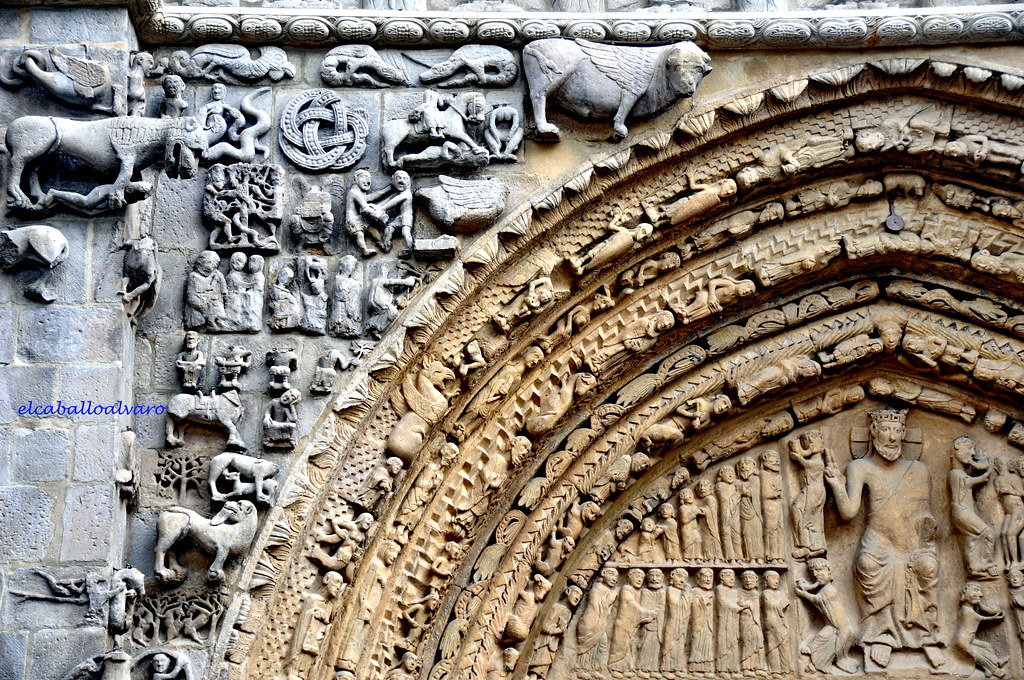Join Amazon Prime - Watch Thousands of Movies & TV Shows Anytime - Start Free Trial Now

Join Amazon Prime - Watch Thousands of Movies & TV Shows Anytime - Start Free Trial Now
Soldiers in facemask helmets
on the portal of Santa María la Real de Sangüesa, Navarre, c.1200.

Portada y torre de Santa María la Real de Sangüesa
Façade and tower of Santa María la Real de Sangüesa
Photo by Pedro M. Mielgo, 2010 (before a protective surround was installed.)
The upper two registers of the façade are by Leodegarius.
The portal is by the Master of San Juan de la Peña (aka Maestro de Agüero), c.1200AD.

Enjuta derecha Right spandrel
Photo by Alberto Rodriguez, 2013

Soldier in facemask helmet on the right spandrel
Source: romanico en navarra

Arquivoltas Detail of the archivolts of the left of the portal
Photo by Elcaballoalvaro, 2012

Soldier in facemask helmet on the 5th, outer, row of figures on the archivolts
Source: romanico en navarra

The same soldier in facemask helmet on the 5th, outer, row of figures on the archivolts
Photo by Roger Joseph, 2015
LEODEGARIUS
Master sculptor, author of the figures that occupy the jambs of the façade of Santa María la Real de Sangüesa. He wanted his work not to be anonymous and he sculpted "Leodegarius me fecit" on the book that the Blessed Virgin carries
...
Its chronology dates from the late 12th or early 13th century, a time corresponding to a construction phase of the church in which the façade was rebuilt. Some of the spandrel and archivolt sculptures made to fill gaps correspond to the same moment.
...
The work of the master Leodegerius coexists with that of other artists, authors of other sculptures that make up the monumental portal, such as the so-called “master of San Juan de la Peña”, author of the Apostolate in double frieze that culminates it, but others do not. Four more hands have been differentiated.
Source: Gran Enciclopedia de Navarra
MAESTRO DE AGÜERO
The chronology proposed by Crozet (from h. 1145-1175) being rejected as excessively early, the latest studies undertaken by Lacoste seem to show a stylistic affiliation of Castilian origin, in the workshop that elaborates the façade of Sto. Domingo de Soria, with a date close to 1200 for the first productions, and the first years of the 13th century for the following.
Source: Gran Enciclopedia Aragonesa
Referenced as figure 329 in Arms and Armour of the Crusading Era, 1050-1350, Western Europe and the Crusader States by David Nicolle.
329A—B Carvings, Navarre, c.1155
(in situ south door, Santa Maria la Real, Sangüesa, Spain)
Though crudely and simply carved, these little figures are amongst the clearest representations of a helmet with a fixed visor or oversized nasal. The bowl of the helmet also extends some way down the backs of the wearers’ necks.
See also Medieval face-mask and transitional helmets.
Navarre Picture Bible, Pamplona, Spain, 1197AD. Bibliothèque d'Amiens Métropole MS.108.
Other Spanish Illustrations of Costume & Soldiers
12th century Illustrations of Costume and Soldiers
13th century Illustrations of Costume and Soldiers







